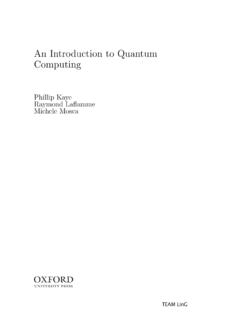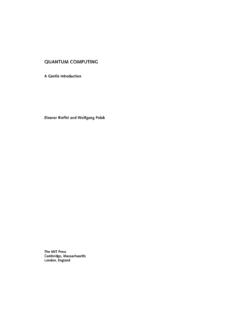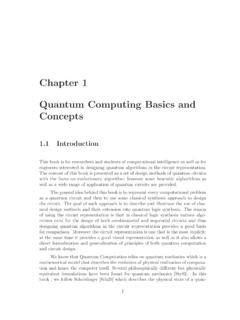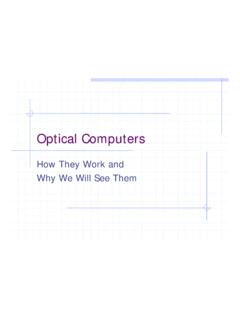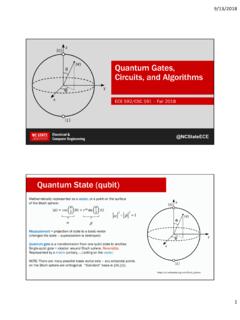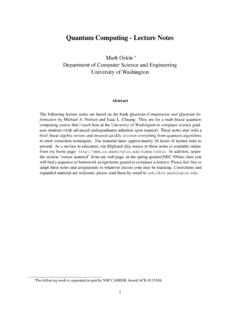Transcription of Quantum Mechanics Made Simple: Lecture Notes
1 Quantum Mechanics Made Simple: Lecture NotesWeng Cho CHEW1 October 5, 20121 The author is with U of Illinois, Urbana-Champaign. He works part time at Hong Kong U Introduction .. Quantum Mechanics is Bizarre .. The Wave Nature of a Particle Wave Particle Duality ..22 Classical Introduction .. Lagrangian Formulation .. Hamiltonian Formulation .. More on Hamiltonian .. Poisson Bracket ..123 Quantum Mechanics Some Introduction .. Probabilistic Interpretation of the wavefunction .. Simple Examples of Time Independent Schr odinger Equation .. in a 1D Box .. Scattering by a Barrier .. in a Potential Well .. The Quantum Harmonic Oscillator ..234 Time-Dependent Schr odinger Introduction .. Quantum States in the Time Domain .. Coherent State.
2 Measurement Hypothesis and Expectation Value .. Evolution of the Hamiltonian Operator .. Principle .. Current ..32iiiQuantum Mechanics Made Simple5 Mathematical A Function is a Vector .. Operators .. Representation of an Operator .. Expansion of an Operator .. of an Operator .. Operators .. Operators .. Identity Operator in a Continuum Space .. Changing Between Representations .. Coordinate Basis Function .. Commutation of Operators .. Expectation Value and Eigenvalue of Operators .. Generalized Uncertainty Principle .. Time Evolution of the Expectation Value of an Operator .. Periodic Boundary Condition ..546 Approximate Methods in Quantum Introduction .. Use of an Approximate Subspace .. Time Independent Perturbation Theory .. Tight Binding Model.
3 Method .. Dependent Perturbation Theory ..677 Quantum Mechanics in Introduction .. Bloch-Floquet Waves .. Bloch-Floquet Theorem for 3D .. Effective Mass Schr odinger Equation .. Density of States (DOS) .. DOS in a Quantum Well ..818 Angular Introduction .. Trapped in a Pill Box .. Trapped in a Spherical Box .. Mathematics of Angular Momentum .. L2 Operator ..92 Contentsiii9 Introduction .. Spin Operators .. The Bloch Sphere .. Spinor .. Pauli Equation ..9910 Identical Introduction .. Pauli Exclusion Principle .. Exchange Energy .. Extension to More Than Two Particles .. Counting the Number of Basis states .. Examples .. Thermal Distribution Functions .. 10711 Density Pure and Mixed States.
4 Density Operator .. Time Evolution of the Matrix Element of an Operator .. Interaction of Light with Two-Level Atomic System .. 11512 Quantization of Classical Introduction .. The Quantum Harmonic Oscillator Revisited .. Eigenfunction by the Ladder Approach .. Quantization of Waves on a Linear Atomic Chain Phonons .. Schr odinger Picture versus Heisenberg Picture .. The Continuum Limit .. Quantization of Electromagnetic Field .. Hamiltonian .. Field Operators .. Multimode Case and Fock State .. One-Photon State .. Coherent State Revisited .. 14113 Schr odinger Wave Introduction .. Fock Space for Fermions .. Field Operators .. Similarity Transform .. Additive One-Particle Operator.
5 Three-Particle Case .. Additive Two-Particle Operator .. More on Field Operators .. 155ivQuantum Mechanics Made Boson Wave Field .. Boson Field Operators .. One-Particle Operator .. Difference between Boson Field and Photon Field .. 16014 Interaction of Different Introduction .. Interaction of Particles .. Time-Dependent Perturbation Theory .. Absorption .. Spontaneous Emission .. Stimulated Emission .. Multi-photon Case .. Total Spontaneous Emission Rate .. 16715 Quantum Information and Quantum Introduction .. Quantum Cryptography .. No-cloning Theorem .. Entangled States .. A Simple Quantum Encryption Algorithm.. Quantum Computing .. Quantum Bits (Qubits) .. Quantum Gates.
6 Quantum Computing Algorithms .. Quantum Teleportation .. Interpretation of Quantum Mechanics .. EPR Paradox .. Bell s Theorem .. Prediction by Quantum Mechanics .. Prediction by Hidden Variable Theory .. A Final Word on Quantum Parallelism .. 187A Generators of Translator and Infinitesimal Translation .. Infinitesimal Rotation .. Derivation of Commutation Relations .. 193B Quantum Statistical Introduction .. Distinguishable Particles .. Identical Fermions .. Identical Bosons .. Most Probable Configuration .. Distinguishable Particles .. Identical Fermions .. Identical Bosons .. The Meaning of and .. 200C Gaussian Wave Introduction .. Derivation from the Wave Equation.
7 Physical Interpretation .. Stability of the Plane Wave Solution .. 207viQuantum Mechanics Made SimplePrefaceThis set of supplementary Lecture Notes is the outgrowth of a course I taught, ECE 487, Quantum Electronics, at ECE Department, University of Illinois at Urbana-Champaign. Itwas intended to teach Quantum Mechanics to undergraduate students as well as graduatestudents. The primary text book for this course is Quantum Mechanics for Scientists andEngineers by Miller. I have learned a great deal by poring over Miller s book. Butwhere I feel the book to be incomplete, I supplement them with my Lecture Notes . I try toreach into first principles as much as I could with these Lecture Notes . The only backgroundneeded for reading these Notes is a background in undergraduate wave physics, and would still recommend using Miller s book as the primary text book for such a course,and use these Notes as supplementary to teach this topic to Cho CHEWO ctober 5, 2012 AcknowledgementsI like to thank Erhan Kudeki who encouraged me to teach this course, and for havingmany interesting discussions during its teaching.
8 I acknowledge interesting discussions withFuchun ZHANG, Guanhua CHEN, Jian WANG, and Hong GUO (McGill U) at Hong also like to thank many of my students and researchers who have helped type the notesand proofread them. They are Phil Atkins, Fatih Erden, Tian XIA, Palash Sarker, JunHUANG, Qi DAI, Zuhui MA, Yumao WU, Min TANG, Yat-Hei LO, Bo ZHU, and Mechanics Made SimpleChapter IntroductionQuantum Mechanics is an important intellectual achievement of the 20th century. It is oneof the more sophisticated field in physics that has affected our understanding of nano-meterlength scale systems important for chemistry, materials, optics, and electronics. The existenceof orbitals and energy levels in atoms can only be explained by Quantum Mechanics . Quantummechanics can explain the behaviors of insulators, conductors, semi-conductors, and giantmagneto-resistance.
9 It can explain the quantization of light and its particle nature in additionto its wave nature. Quantum Mechanics can also explain the radiation of hot body, and itschange of color with respect to temperature. It explains the presence of holes and the transportof holes and electrons in electronic Mechanics has played an important role in photonics, Quantum electronics,and micro-electronics. But many more emerging technologies require the understanding ofquantum Mechanics ; and hence, it is important that scientists and engineers understandquantum Mechanics better. One area is nano-technologies due to the recent advent of nano-fabrication techniques. Consequently, nano-meter size systems are more common place. Inelectronics, as transistor devices become smaller, how the electrons move through the deviceis quite different from when the devices are bigger: nano-electronic transport is quite differentfrom micro-electronic quantization of electromagnetic field is important in the area of nano-optics andquantum optics.
10 It explains how photons interact with atomic systems or materials. It alsoallows the use of electromagnetic or optical field to carry Quantum information. Moreover, Quantum Mechanics is also needed to understand the interaction of photons with materials insolar cells, as well as many topics in material two objects are placed close together, they experience a force called the Casimirforce that can only be explained by Quantum Mechanics . This is important for the un-derstanding of micro/nano-electromechanical sensor systems (M/NEMS). Moreover, the un-derstanding of spins is important in spintronics, another emerging technology where giantmagneto-resistance, tunneling magneto-resistance, and spin transfer torque are being Mechanics is also giving rise to the areas of Quantum information, quantum12 Quantum Mechanics Made Simplecommunication, Quantum cryptography, and Quantum computing.
